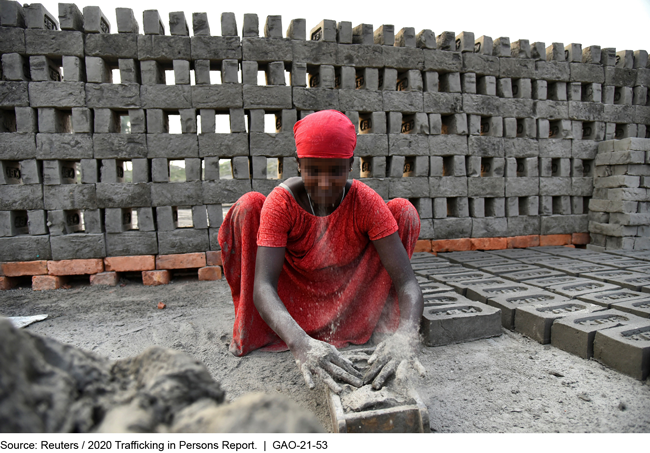Human Trafficking: Agencies Have Taken Steps to Strengthen International Anti-trafficking Projects
Fast Facts
Worldwide, millions of people are exploited by human trafficking. The Departments of State and Labor and the U.S. Agency for International Development managed 182 international anti-trafficking projects aimed at preventing trafficking, prosecuting perpetrators, and protecting survivors.
The agencies have evaluated the effectiveness of some of their projects. The evaluations cited improved awareness and collaboration as project successes. Agency officials noted challenges that make it difficult to evaluate anti-trafficking projects. For example, data is not readily available because of the hidden nature of trafficking.
According to State, this woman was exploited through bonded labor at a brick factory in rural India.

Highlights
What GAO Found
The Department of State (State), the U.S. Agency for International Development (USAID), and the Department of Labor (DOL) managed 182 international anti-trafficking in persons projects, totaling at least $316 million, during fiscal year 2018 and the first half of fiscal year 2019. These projects aim to support prosecution of perpetrators of trafficking, protect survivors, and prevent trafficking.
Indian Woman Exploited through Bonded Labor at a Brick Factory in Rural India, According to State 
State's Program to End Modern Slavery represents a large U.S. investment to combat international human trafficking. Under this program, prime award recipients have administered 22 subawards, worth $13.8 million, for international anti-trafficking projects and human trafficking research. For subawards reviewed, GAO found that State, among other things, had reviewed and approved country selection, industry selection, and subaward recipients.
Agencies are taking steps to address challenges to evaluating international anti-trafficking projects and have completed final evaluations that examine project effectiveness. Despite longstanding challenges to evaluating anti-trafficking projects, given the sensitivities of human trafficking, agencies are taking steps to improve data, resources, and project design. In addition, State, USAID, and DOL completed a total of eight final evaluations of their anti-trafficking projects that were active from fiscal years 2016 through 2018 and provided information on the extent to which these projects achieved their objectives. For example, the final evaluations identified project achievements related to improved awareness, collaboration, and institutional capacity, among other things. They also identified project challenges, such as limited resources.
State, USAID, and DOL generally followed their policies for using midterm evaluation findings and recommendations to strengthen ongoing projects. Specifically, the agencies used midterm evaluations to make course corrections to improve project performance. For example, State provided additional funding and a time extension to an implementing partner, in response to a midterm evaluation recommendation. Continuing to follow their policies for using evaluations could help the agencies better address impediments, manage foreign assistance, and meet their programmatic goals.
Why GAO Did This Study
Human trafficking, a multi-billion dollar industry, is a pervasive problem throughout the world. In addition to harming its victims, it imposes social and public health costs and undermines government authority.
The National Defense Authorization Act for Fiscal Year 2017 includes a provision for GAO to report on programs conducted by specific agencies, including State, USAID, and DOL, which address trafficking in persons. This report (1) describes recent international anti-trafficking in persons projects that key U.S. agencies have awarded to implementing partners; (2) describes State's Program to End Modern Slavery, and the extent to which State conducted oversight for subaward selection; (3) describes agencies' U.S. international anti-trafficking project evaluation efforts, including actions agencies are taking to address challenges to such evaluations; and (4) examines the extent to which agencies used selected midterm evaluations to strengthen ongoing projects, among other things.
GAO reviewed agency policies, data, awards and other documents; conducted a literature search; and reviewed eight final evaluations and six midterm evaluations of anti-trafficking projects funded by State, USAID, and DOL that were active at any point from fiscal years 2016 through 2018. GAO conducted fieldwork in the Philippines, which it selected to observe all three agencies' anti-trafficking projects. GAO also interviewed agency officials and implementing partners.
For more information, contact Chelsa Kenney Gurkin at (202) 512-2964 or gurkinc@gao.gov.
